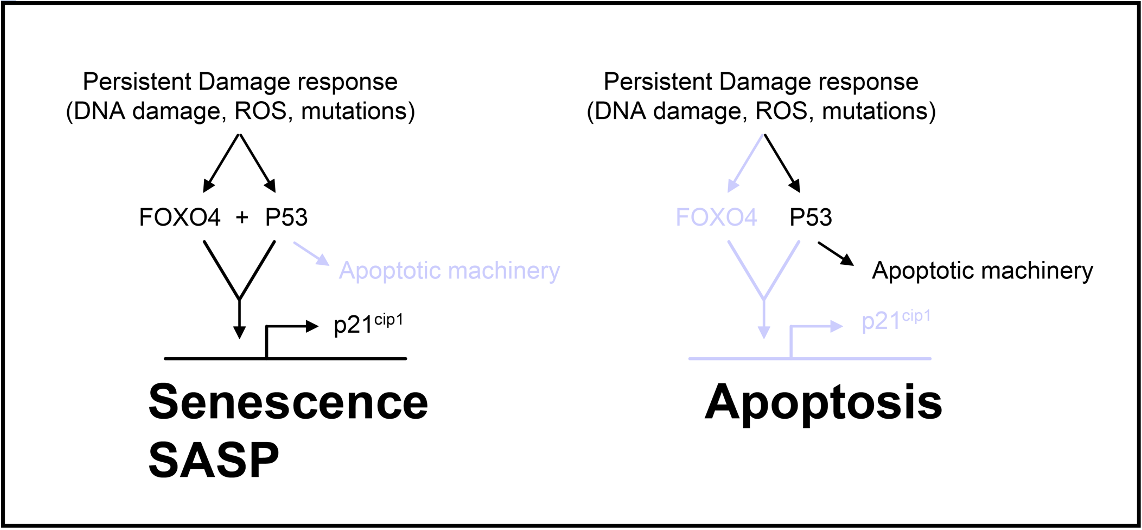Cleara Biotech B.V. was founded in order to translate academic findings to benefit patients. Some historical highlights that provided rationale for translation through Cleara include:
2008
FOXO4 and p53 can physically interact in cells. Both proteins are involved in how cells response to damage and stress, but were so far mostly considered to have separate biological roles. The FOXO4/p53 interaction is especially elevated under conditions of stress. Subsequently, molecular feedback loops are activated to counter the negative consequences. Phosphorylation of p53 on a particular residue can occur under such conditions – something which has become important to Cleara’s development later on.
2009
Hyperactivating mutations in proteins that promote cellular growth and/or proliferation (oncogenes) can cause a persistent form of cellular stress. Subsequently, such chronic stress signaling can cause cells to become senescent (or senescence-like, in case of cancer cells). FOXO proteins are downstream targets of at least some of these senescence responses. Under these conditions, FOXO4 phosphorylation and binding to p53 occurs. Importantly, inhibition of FOXOs in such cells tipped the balance from senescence towards apoptosis. This lead to the following model (e.g. P.L.J. de Keizer, Ph.D. dissertation and “de Keizer et al., 2010, Cancer Research”):

2010
Identification by our team that FOXO4 is a pivot in maintaining the viability of senescent cells. Using fibroblasts induced to senesce by ionizing radiation, we further observed that p53 is phosphorylated on Serine 46 and that removing FOXO4 could trigger a “clean” cell death response, known as apoptosis (de Keizer&Campisi, Cancer Res (2011) 71 (18_Supplement): C35.). This created a new window of opportunity to eliminate these deleterious cells. As we found FOXO4 to also exert a protective response to chemotherapy, it additionally opened the door towards development of methods to overcome therapy resistance of cancer cells.
2012
Generation of the first and second generation of compounds to eliminate senescent and therapy-resistant cancer cells (e.g. patent US20130288981 A1; 2012). Here, we showed for the first time that not only inhibition of FOXO4 itself, but more specifically, blocking the FOXO4-p53 binding by cell-penetrating peptides could effectively eliminate senescent cells and therapy-resistant cancer cells. A downside was that these peptides were based on regular “L” amino acids, something which we addressed next.
2015
Development of the third generation of FOXO4-based anti-senescence drugs: the FOXO4-DRI peptide. In contract to the earlier versions, this peptide fully contained “D”-amino acids. Moreover, the sequence was inverted. This 3rd generation FOXO4-DRI proved to be effective in counteracting signs of chemotoxicity and, excitingly, was able to restore healthspan in models for fast and natural aging, e.g. fur density, behavior and renal function. (Baar et al., Cell, 2017). This research received worldwide media attention, including coverage in numerous TV and radio shows, newspapers and blogs. Multiple other groups have shown benefits of FOXO4-DRI against (age-related) diseases in mouse models.
2018
Incorporation of Cleara to continue our evolution of FOXO4-based anti-senescence drugs and generate the fourth generation capable of human translation. A problem we encountered was that that “aging” is not an easy target for clinical trials. Moreover, the selectivity of the 3rd generation peptide was such that we considered improvement to be necessary.
Now
Excitingly, and in contrast to FOXO4-DRI, Cleara’s CL04177 and CL04183 show a strongly enhanced binding to p53 when phosphorylated. A strong proxy marker of this event is the protein PML, something which is particularly present in a type of senescence we call “scarred” senescence. Together, this prompts Cleara to progress these lead compounds for oncology and non-oncological models where “scarring” is present.

